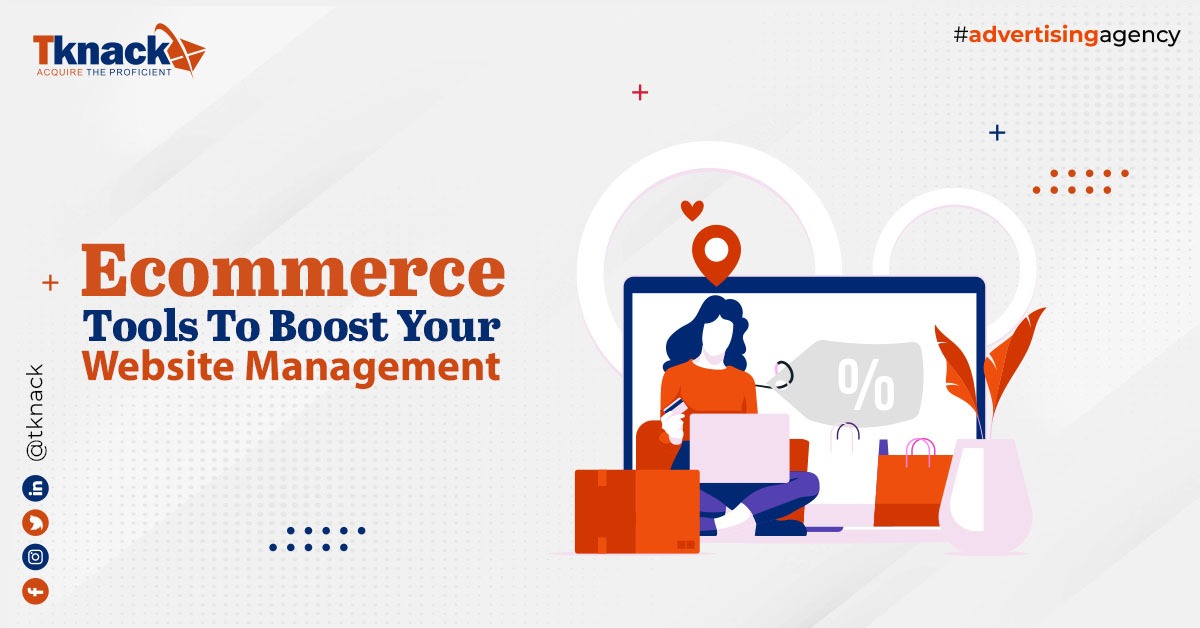Managing an ecommerce website with tools becomes much easier. These tools can be helpful for handling inventory, tracking customer data, or optimizing your website for sales. Here we’ll explore the top ecommerce tools and strategies to enhance your website management and ensure your online store runs smoothly.
Table of Contents
What are ecommerce tools?
ECommerce tools are software applications created to enable businesses to handle their online stores effectively. These applications manage fundamental activities such as inventory control, order fulfillment, payment integration, and customer behavior tracking. With the right ecommerce tools integrated, you can:
⦁ Improve site performance.
⦁ Streamline operations.
⦁ Enhance customer experience.
⦁ Boost conversions and revenue.

Top Ecommerce Tools for Website Management
Let’s find top ecommerce tools that simplify website management and raise your online store.
1. ECommerce Platforms
The most popular platforms to boost your website management like Shopify, WooCommerce, and BigCommerce have specific features for an ecommerce business. The platform you use for your ecommerce website should be user friendly and fastloading. These platforms allow you to:
⦁ Update product listings with ease.
⦁ Organize the content for SEO.
⦁ Track user engagement metrics.
⦁ Using an intuitive CMS makes managing your site’s content easy.
2. Inventory Management Systems
Stock levels need to be tracked for ecommerce success. Integrations with your website by TradeGecko, Zoho Inventory, and Stocky include:
⦁ Real-time inventory tracking.
⦁ Automated stock alerts.
⦁ Detailed analytics for demand forecasting.
Overstocking and stockouts are avoided through such systems, thus avoiding any form of inconvenience for customers.

3. CRM Software
Building long-term success means building a good relationship with customers. With these systems, you will be able to:
⦁ Personalize marketing efforts.
⦁ Monitor customer interactions.
⦁ Start sending email campaigns.
An example is an ecommerce jewelry business with CRM, which sells hand-made jewelry, and uses the purchase history to classify customers. As such, with the promotion offered to those who previously acquired necklaces on matching earrings, their sales would hit high marks. This customization approach will not only sustain the customer but also enhances their satisfaction as they’ll feel well-understood and loved.
4. Payment Gateway
Streamlined payment systems are required for seamless transactions. Tools such as Stripe, PayPal, and Square ensure safe and smooth payment processing. These services offer the following features:
⦁ Multi-currency support.
⦁ Fraud prevention.
⦁ Integration with mobile and desktop sites.
⦁ Simplification of payments results in greater customer trust and conversions.
5. SEO Tools
SEO is a necessity to attract organic traffic. Tools like Google Analytics, Ahrefs, and SEMRush help you:
⦁ Monitor website performance.
⦁ Conduct keyword research.
⦁ Track visitor behavior.
These insights help you optimize your strategies and stay ahead of competitors.
6. Heatmap Tools
Heatmap tools like Hotjar and Crazy Egg. These tools help you:
⦁ Visualize user behavior through detailed click and scroll maps.
⦁ Identify drop-off points and areas of low engagement.
⦁ Prioritize which pages to optimize first based on user behavior data.
For instance, if a heatmap highlights that most users leave the checkout page at a certain field, you can redesign that particular section to minimize friction. Heatmaps offer actionable insights in order to enhance the experience of the user and make more conversions.
7. Analytics and Reporting Tools
Data-driven decisions are essential for ecommerce success. Analytics tools such as Google Analytics and Tableau offer extensive understanding of your site’s performance, allowing you to:
⦁ Track key metrics
⦁ Identify growth opportunities.
⦁ Quantify marketing campaign effectiveness.

8. Product Recommendation Engines
Sales are increased through the provision of personalized shopping experiences. AI-powered tools, including Nosto and Dynamic Yield, are used for:
⦁ Recommending appropriate products to customers.
⦁ Increase in average order value
⦁ Enhance customer satisfaction.
9. A/B Testing Platforms
Use platforms like Optimizely and VWO to optimize your website. Through these tools, you can:
⦁ Test various designs and layouts
⦁ Know what works best.
⦁ Enhance user experience
10. Dynamic Pricing Software
Stay competitive with dynamic pricing tools like Prisync and RepricerExpress. These tools:
Tend to change prices based on market trends.
⦁ Increase profit.
⦁ Enhance competitiveness.
Dynamic pricing software is especially helpful in travel and retail, as there is a frequent change in the price due to fluctuations in demand. For instance, airlines always employ dynamic pricing by adjusting the ticket price based on demand to ensure that it does not incur losses during peak seasons. Likewise, retail businesses use such tools during holiday sales to be competitive and increase revenue.
11. Visual Merchandising Platforms
Show the product in the best display using Four Sixty, Limespot, or any other similar tool:
The visually appealing displays of the products.
Higher engagement.
More conversions
12. Email Marketing Automation
Email marketing is definitely one of the most profitable channels for ecommerce businesses, as tools like Mailchimp, Klaviyo, and Constant Contact help send out:
⦁ Automated mailer designs.
⦁ Audiences segmented on behavior.
Open, click-through rates. Managed emails keep your customers interacting and informed.
13. Social Proof Tools
Build trust with social proof tools like Yotpo and Trustpilot. These tools display reviews, ratings, and customer testimonials to encourage potential buyers to trust your brand.
14. Shipping and Fulfillment Software
Streamline order fulfillment with tools like ShipStation and Easyship. They:
⦁ Automate shipping processes.
⦁ Offer real-time tracking.
⦁ Reduce delivery times.
15. Use OF Chatbots
You can use chatbots to improve your website’s customer support system.
Because Chatbots:
⦁ Respond instantly.
⦁ Answer common queries.
⦁ Improve customer satisfaction.
16. Customer Feedback Tools
Know customer preferences using SurveyMonkey and Qualtrics. Collecting feedback enables you to:
⦁ Identify improvement areas.
⦁ Improve user experience.
⦁ Strengthen relationships.
17. Content Creation Tools
Create interesting content using Canva and Adobe Spark. These tools assist in designing:
⦁ Social media graphics.
⦁ Product visuals.
⦁ Blog images.
18. Lead Generation Tools
Use lead generation tools like OptinMonster and HubSpot Marketing Hub to attract potential customers. These platforms help capture email leads, provide personalized experiences, and drive conversions.

19. Advertising Tools
Use popular advertising tools such as Google Ads and Facebook Ads Manager. These tools have the ability to reach specific audiences, optimize ad spend, and increase traffic and sales.
In measuring the ROI of these tools, key performance indicators (KPIs) would be
⦁ Click-through rates
⦁ Conversion rates
⦁ Return on ad spend.
Constant measurement of these metrics will allow you to ensure that you are using your advertising budget effectively and in line with your business goals.
20. Social Media Scheduling Tools
Use scheduling tools for Streamlining your social media strategy such as Buffer and Hootsuite. They:
⦁ Schedule posts.
⦁ Engagement metric tracking.
⦁ Account management on multiple platforms
21. Loyalty Program Software
Keep your customers coming back with loyalty program tools. The platforms will assist you:
⦁ Reward repeat buys.
⦁ Establish customer loyalty
⦁ Increase the lifetime value of customers.
22. Personalization Tools
Personalization tools transform shopping experiences into something unique and personal, catering to the needs of every customer. Dynamic Yield and Evergage are some platforms that allow businesses to personalize recommendations, emails, and even website layouts based on user behavior.
For example, an online clothing store may suggest jackets to customers who are browsing winter apparel categories, thus aligning suggestions with their interests. Such personalization not only increases customer satisfaction but also loyalty. When customers feel understood, they are likely to return, thus increasing their lifetime value and strengthening your brand.
23. AI Tools for Ecommerce
Use artificial intelligence with tools like ChatGPT and Albert AI. These tools:
⦁ Automate customer support.
⦁ Optimize marketing strategies.
⦁ Improve decision-making.
How to Choose the Right Ecommerce Tools
Selecting the right ecommerce tools depends on your business needs. Here’s how to make the right choice:
1. Assess Your Needs
Determine which areas of website management require improvement. Whether it’s content updates, SEO, or customer support, identify your priorities.
2. Look for Integration
Choose tools that integrate seamlessly with your existing systems. Compatibility ensures smooth operations and avoids technical issues.
3. Consider Scalability
As your business evolves, so should your tools. Choose tools that allow for scalable features to address future needs.
4. Test Before Committing
Most tools provide free trials or demos. Take these opportunities to test the functionalities and determine if they work for you.

Advantages of Using Ecommerce Tools for Website Management
Implementation of the right tools presents a lot of benefits in terms of:
Time Saved: Automated tasks such as updating the inventory and email marketing save time.
Improved Accuracy: Tools decrease human error in stock tracking and analytics.
Better User Experience: Faster sites, personalized marketing, and real-time support make the customer happy.
Increased Revenue: Streamlined operations and better SEO bring more traffic and conversions.
Empower Your Ecommerce Journey with TKnack
Selecting the bestecommerce tools for your business can be a cumbersome process. Tknack makes it easy by providing:
⦁ Expert reviews of top ecommerce tools.
⦁ Comparison features to make informed decisions.
⦁ Delivering personal recommendations based on your business needs.
Whether you are starting or scaling your ecommerce business, TKnack makes sure to select tools that fit your needs. Through the effective integration of these tools, you can boost efficiency, increase sales, and provide the best customer experience. Empower your ecommerce journey with the right solutions and make your business thrive.




